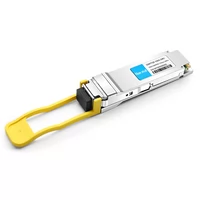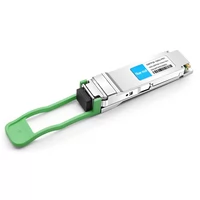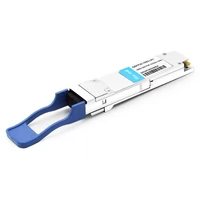Abstract: It is an unprecedented time for the development of data centers due to the mass data demand stimulated by diverse network applications and high-density computing powered by Artificial Intelligence. Such Information Technologies has driven the data center towards a higher density and higher bandwidth development. According to the source, the number of QSFP28 optical modules used for optical interconnection in data centers has approached 3 million within the year 2017 and continues to grow at a compound annual growth rate of more than 100% until 2021.
Technologies applied in 100G QSFP28 optical transceivers series for IDC have come to their maturity. The second half of 2016 saw a rapid increase in optical modules, among which the QSFP28 was the fastest-growing product used for optical interconnection within the data center. Please refer to the following figure of Ethernet Modules Volume.

1. 100G Single-Lambda (QSFP28 DR1/FR1)- Market-Favored Solutions
Optical transceivers based on 4*25G NRZ technology have been the main 100G network solutions in the current market. There is a wide range of products back by this technology including SR4 / SWDM4 with a transmission distance of 100m, eSR4 300m, PSM4 / CWDM4-lite 500m, CLR4, and CWDM4 2km respectively. However, the diversity of these products has provoked great difficulties to the interconnection and compatibility of the Internet, thereby increasing the cost of the data center. Therefore, 100G Single-Lambda optical modules have attracted growing attention from Internet companies.
According to the IEEE Standard, 100G Single-Lambda QSFP28 DR1, FR1, and LR1 based on PAM4 modulation are a physical media dependence supporting a single-channel of 100Gbps (53GBd). Compared with the existing 100G QSFP28 optical modules(4*25 Gbps channels), DR1 and FR1 support 500m and 2km transmission distance on SMFs respectively, and only one optical device is deployed in both of them, which significantly save the cost of the optical modules. Moreover, DR1, FR1, and LR1(with 10km link length) optical transceivers in QSFP28 Form Factor is fully compatible with the current 100G switches.
2. 100G Single-Lambda Optical Module-Best Solution for NextGen IDC Update
100G QSFP28 DR1, FR1, and LR1, from the perspective of the application, can be regarded as the best 100G QSFP28 optical transceivers solution with their capacity to cover most of the transmission distances of optics interconnect in data centers at present. They are expected to replace all the current QSFP28 optical transceivers within 500m link length, avoiding problems in 100G optics solution selection and interconnect. DR1 also applies in the fan-out connection with DR4, working for top-of-rack switches and servers. In terms of the evolution of technology R&D, DR1/FR1 can accumulate corresponding data for the development of DR4/FR4 (the photoelectric solutions are the same case, but the channel requires extension).

Technically Speaking, 100G QSFP28 DR1, FR1, and LR1 use PAM4 modulation technology, which greatly improves the signal rate and can effectively reduce the number of signal channels compared to NRZ modulation technology. What’s more, this technology replaces the existing NRZ modulation technology on next-generation 400G optical module products by contracting the size of the optical module and reducing power consumption, thus saving the cost of the optical module.
3. FiberMall 100G Single-Lambda Optical Transceiver – a Boost to IDC Update
FiberMall has been keen on the R&D in optics products and introduces 100G QSFP28 FR1, DR1, and LR1 optical modules to meet the market demand. This full series of 100G Single-Lambda Optical Transceiver integrates the PAM chip, and converts the 4-channel 25Gbps NRZ signal on the circuit side into a single 53G baud rate, i.e. the 100G bit rate PAM4 signal becomes a single-wave 100G optical signal through the driver and the modulator and transmits it to the optical channel.
Conclusion
FiberMall professionally combines the electrical chips and the optical chips by its designing excellence in high-speed form factor and high-frequency circuits for optical modules.100G Single-Lambda technology lays a solid foundation for the next generation network deployment in data centers, thereby accelerating the development of the network towards flattening and higher bandwidth.
Table of Contents
ToggleRelated Products:
-
 QSFP28-100G-DR1 100G QSFP28 Single Lambda DR 1310nm 500m LC SMF with FEC DDM Optical Transceiver
$180.00
QSFP28-100G-DR1 100G QSFP28 Single Lambda DR 1310nm 500m LC SMF with FEC DDM Optical Transceiver
$180.00
-
 QSFP28-100G-FR1 100G QSFP28 Single Lambda FR 1310nm 2km LC SMF with FEC DDM Optical Transceiver
$215.00
QSFP28-100G-FR1 100G QSFP28 Single Lambda FR 1310nm 2km LC SMF with FEC DDM Optical Transceiver
$215.00
-
 QSFP28-100G-LR1 100G QSFP28 Single Lambda LR 1310nm 10km LC SMF with FEC DDM Optical Transceiver
$265.00
QSFP28-100G-LR1 100G QSFP28 Single Lambda LR 1310nm 10km LC SMF with FEC DDM Optical Transceiver
$265.00



